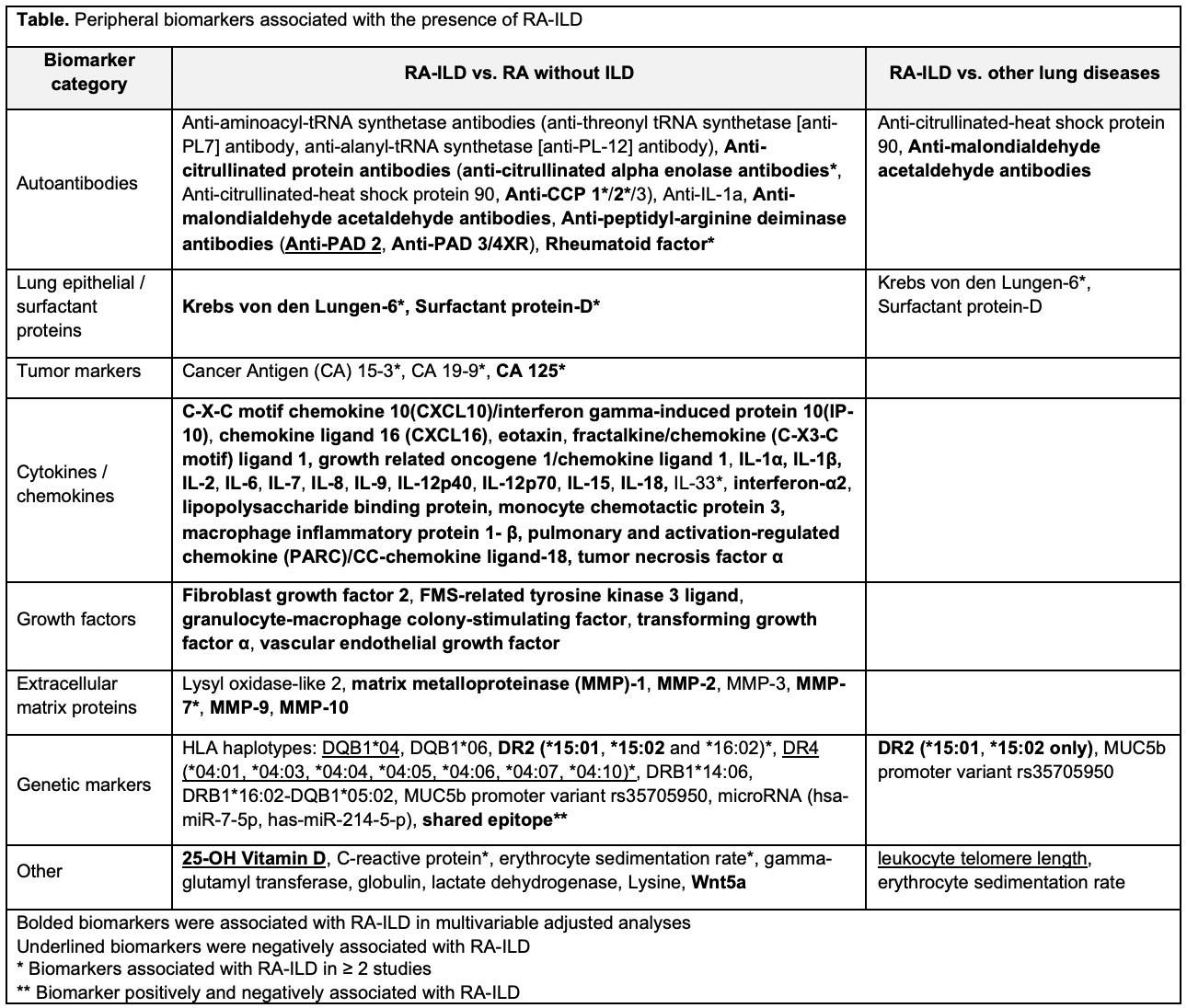Session Information
Date: Sunday, November 8, 2020
Title: RA – Diagnosis, Manifestations, & Outcomes Poster III: Cardiopulmonary Aspects
Session Type: Poster Session C
Session Time: 9:00AM-11:00AM
Background/Purpose: RA-associated interstitial lung disease (RA-ILD) is among the most frequent and severe extra-articular manifestations of RA, contributing significantly to the excess mortality among RA patients. Optimal methods to identify RA-ILD and prognosticate its disease course are lacking. Peripheral biomarkers capable of performing these roles would be of great utility in the management of RA-ILD. To summarize this evidence, we performed a systematic review of peripheral biomarkers for the identification and prognosis of RA-ILD.
Methods: We performed a systematic review of published manuscripts investigating peripheral biomarkers in RA-ILD (PROSPERO registration number CRD42019137143) following PRISMA guidelines. We searched MEDLINE, EMBASE, the Cochrane Library, and Scopus from inception to 12/10/2019. We included primary studies evaluating peripheral biomarker(s) for the identification or prognostication of RA-ILD. We excluded those in non-English language, studies with < 20 RA-ILD patients, published reports prior to 1990 (given advancements in imaging for RA-ILD), and those not reporting results for RA-ILD specifically (e.g. grouped with CTD-ILD). We extracted study characteristics (including study design, method of biomarker measurement), patient characteristics (including demographics, smoking status, RA disease severity, and method of ILD ascertainment), and performance of peripheral biomarkers for identifying RA-ILD (vs. RA without ILD; or vs. other lung diseases) and predicting prognosis. We assessed the quality of studies using modified Quality Assessment of Diagnostic Accuracy Studies-2 (QUADAS-2) and Quality in Prognostic Studies (QUIPS) tools.
Results: Our search identified 1,189 studies, and 43 remained after applying inclusion and exclusion criteria. Study designs were primarily cross-sectional and included patients from the U.S., Japan, and China. Patient characteristics and sample sizes were highly variable across studies. Methods of ILD ascertainment were similar across most studies, typically incorporating imaging criteria (primarily CT) with or without clinical criteria. A total of 71 peripheral biomarkers were identified, with the majority being measured in serum. Peripheral biomarkers associated with the presence of RA-ILD included autoantibodies, lung epithelial/surfactant proteins, tumor markers, cytokines and chemokines, growth factors, extracellular matrix proteins, genetic markers, and other biomarkers (Table). The risk of bias pertaining to patient selection, biomarker testing, reference standard assessment, and flow and timing was generally low or unclear. Several studies were determined to have a moderate to high risk of bias related to the statistical analyses due to lack of adjustment for confounding variables. Only 1 study focused on RA-ILD prognostication.
Conclusion: Several peripheral biomarkers have been found to be associated with the presence of RA-ILD, while few have been evaluated for their role in the prognostication of RA-ILD. Further investigation and clinical validation is needed before these candidate biomarkers can be employed in the care of RA and RA-ILD patients.
 Table. Peripheral biomarkers associated with the presence of RA-ILD
Table. Peripheral biomarkers associated with the presence of RA-ILD
To cite this abstract in AMA style:
Shaver D, Van Kalsbeek D, Ebel A, Hershberger D, Schmidt C, Poole J, Thiele G, Ascherman D, Mikuls T, England B. Biomarkers for Rheumatoid Arthritis-Associated Interstitial Lung Disease: A Systematic Review [abstract]. Arthritis Rheumatol. 2020; 72 (suppl 10). https://acrabstracts.org/abstract/biomarkers-for-rheumatoid-arthritis-associated-interstitial-lung-disease-a-systematic-review/. Accessed .« Back to ACR Convergence 2020
ACR Meeting Abstracts - https://acrabstracts.org/abstract/biomarkers-for-rheumatoid-arthritis-associated-interstitial-lung-disease-a-systematic-review/
